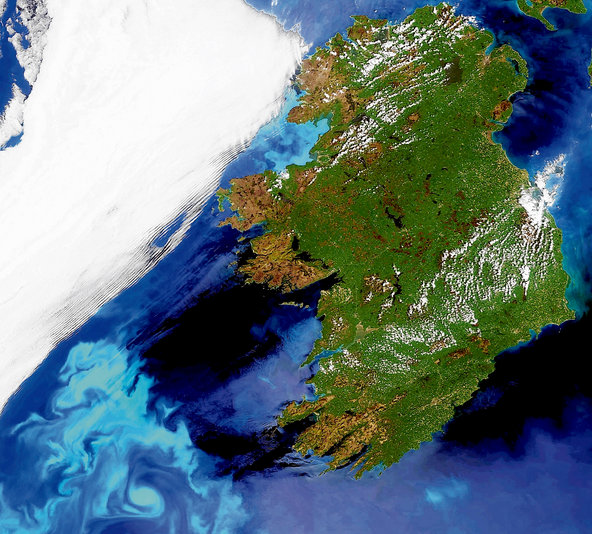
Images of the phytoplankton bloom were captured last week by the European Space Agency and US space agency NASA.
It has caused the sea to turn a milk-white colour, due to the dense accumulation of phytoplankton known as Emiliania huxleyi in response to warm surface water and sunlight.
Billions of microscopic cells have formed the bloom, which tends to occur in summer months.
Marine Institute scientist Joe Silke explained that they "form the base of the marine food chain and are important contributors of atmospheric oxygen and essential components of a healthy oceanic biodiversity".
Mr Silke added: "The presence of this bloom is a good sign that the waters to the west of Ireland are currently in a healthy state."
The Marine Institute has said that there is a "very remote" possibility that oil leaking from the BP well in the Gulf of Mexico will reach European waters.
It said it had no details on the chemical composition of the oil spilled, but in most cases the fuel evaporates into the atmosphere after some days and "the rest generally sinks to the bottom".
Last week, French explorer Jean-Michel Cousteau suggested the Gulf Stream could carry the oil to western Europe. The European Maritime Safety Agency has been monitoring the situation on a daily basis.
Ireland is to nominate experts to assist the US coast guard with the extensive pollution caused by BP's leaking well.
The Irish Coast Guard has also offered the use of pollution control equipment, following a request to all EU member states by the European Commission's Monitoring and Information Centre in Brussels.
The ruptured well has been gushing oil since the Transocean-owned Deepwater Horizon rig exploded and killed 11 people aboard on April 20th.



The Marine Institute has said that there is a "very remote" possibility that oil leaking from the BP well in the Gulf of Mexico will reach European waters.
It said it had no details on the chemical composition of the oil spilled, but in most cases the fuel evaporates into the atmosphere after some days and "the rest generally sinks to the bottom".
Eh? Most crude oil is lighter than water [url=[Link]which means it will float to the top, as opposed to the bottom of water [url=[Link]Also, when it evaporates, it seems to do this: [url=[Link]
As for the "very remote" possibility.. I aint holding my breath..